Objectives Define stake and stakeholder Differentiate





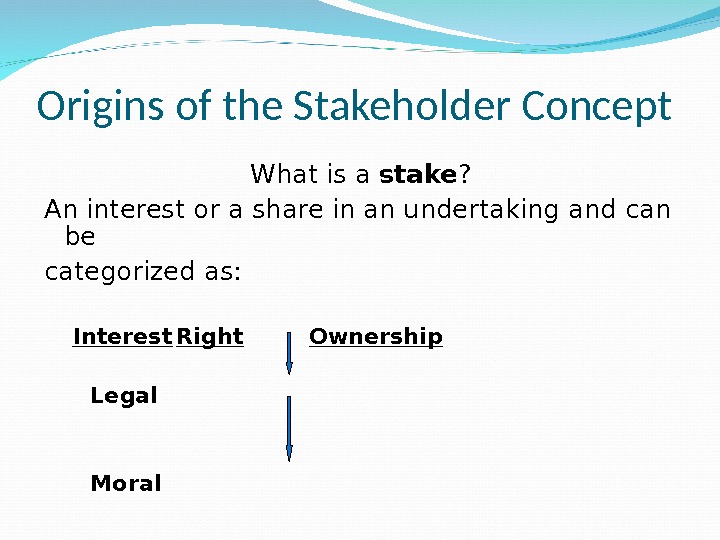

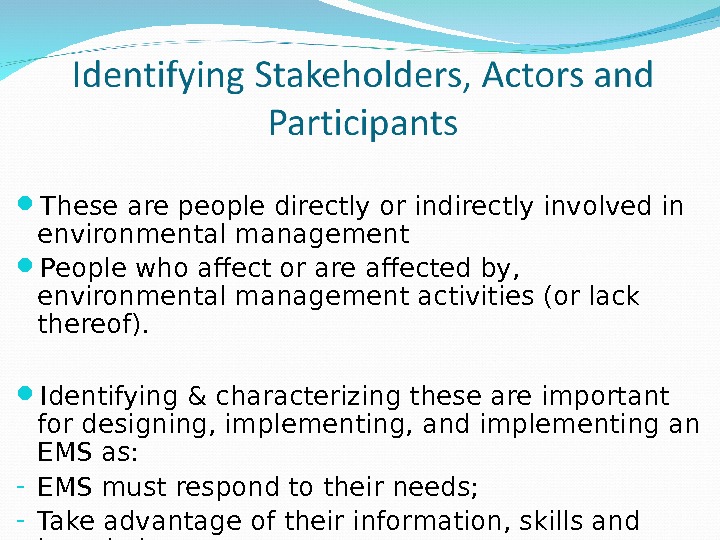


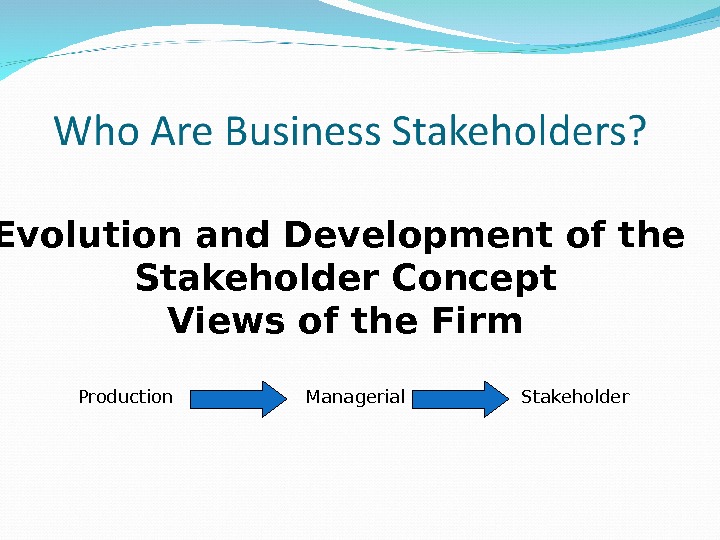







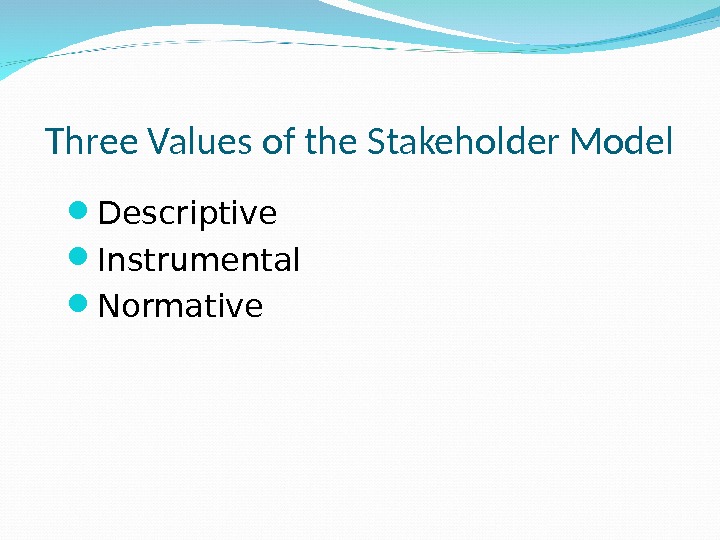



















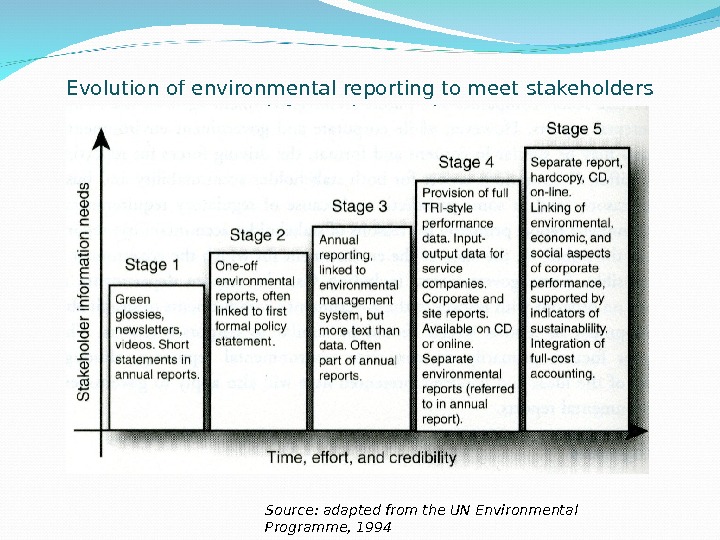



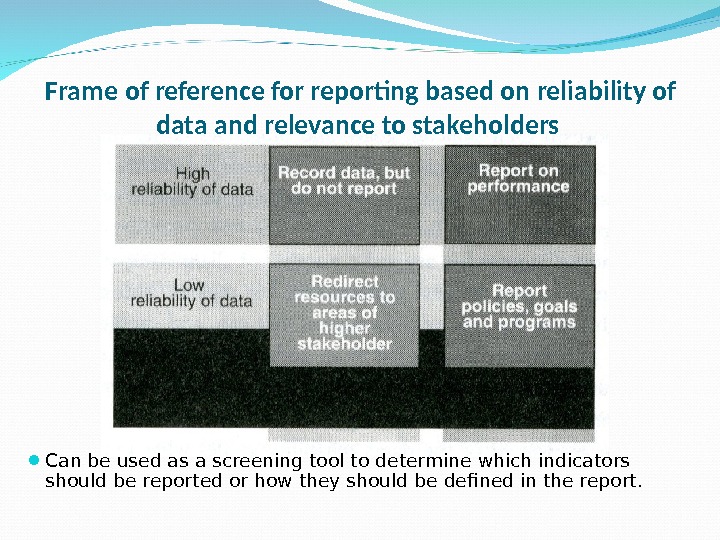






lecture_15_stakeholder_management.ppt
- Размер: 5.5 Mегабайта
- Количество слайдов: 48
Описание презентации Objectives Define stake and stakeholder Differentiate по слайдам

 Objectives Define stake and stakeholder Differentiate between production, managerial, and stakeholder views of the firm Discuss three values of the stakeholder model Consider the concept of stakeholder management Identify the essence of stakeholder management Explain stakeholder management capability (SMC)
Objectives Define stake and stakeholder Differentiate between production, managerial, and stakeholder views of the firm Discuss three values of the stakeholder model Consider the concept of stakeholder management Identify the essence of stakeholder management Explain stakeholder management capability (SMC)
 Origins of the Stakeholder Concept Who Are Business’s Stakeholders? Strategic, Multifiduciary, and Synthesis Views Three Values of the Stakeholder Model Key Questions of Stakeholder Management Effective Stakeholder Management Capability(SMC) The Stakeholder Corporation Stakeholder Power: Four Gates of Engagement Principles of Stakeholder Management Summary
Origins of the Stakeholder Concept Who Are Business’s Stakeholders? Strategic, Multifiduciary, and Synthesis Views Three Values of the Stakeholder Model Key Questions of Stakeholder Management Effective Stakeholder Management Capability(SMC) The Stakeholder Corporation Stakeholder Power: Four Gates of Engagement Principles of Stakeholder Management Summary
 Stakeholders Individuals and groups with a multitude of interests, expectations, and demands as to what business should provide to society.
Stakeholders Individuals and groups with a multitude of interests, expectations, and demands as to what business should provide to society.
 Origins of the Stakeholder Concept What is a stake ? An interest or a share in an undertaking and can be categorized as: Interest Right Ownership Legal Moral
Origins of the Stakeholder Concept What is a stake ? An interest or a share in an undertaking and can be categorized as: Interest Right Ownership Legal Moral

 These are people directly or indirectly involved in environmental management People who affect or are affected by, environmental management activities (or lack thereof). Identifying & characterizing these are important for designing, implementing, and implementing an EMS as: — EMS must respond to their needs; — Take advantage of their information, skills and knowledge; — Identify the opportunities they can provide.
These are people directly or indirectly involved in environmental management People who affect or are affected by, environmental management activities (or lack thereof). Identifying & characterizing these are important for designing, implementing, and implementing an EMS as: — EMS must respond to their needs; — Take advantage of their information, skills and knowledge; — Identify the opportunities they can provide.
 Internal or external Directly or indirectly involved Relationship can be formal (regulated, official or contractual) or informal Involvement can be passive or active Participants can be affected positively, negatively or both Particularly important to identify stakeholders, actors and participants for environmental communication
Internal or external Directly or indirectly involved Relationship can be formal (regulated, official or contractual) or informal Involvement can be passive or active Participants can be affected positively, negatively or both Particularly important to identify stakeholders, actors and participants for environmental communication
 Governmen t Employee s Busines s Communit y Consume rs Owners
Governmen t Employee s Busines s Communit y Consume rs Owners
 Evolution and Development of the Stakeholder Concept Views of the Firm Production Managerial Stakeholder
Evolution and Development of the Stakeholder Concept Views of the Firm Production Managerial Stakeholder
 Production and Managerial Views
Production and Managerial Views

 Primary and Secondary Stakeholders • Primary stakeholders are those stakeholders that have a direct stake in the organization and its success • Secondary stakeholders are those that have a public or special interest stake in the organization
Primary and Secondary Stakeholders • Primary stakeholders are those stakeholders that have a direct stake in the organization and its success • Secondary stakeholders are those that have a public or special interest stake in the organization
 Core, Strategic, and Environmental Stakeholders • Core stakeholders are essential to the survival of the firm • Strategic stakeholders are vital to the organization and the threats and opportunities the organization faces • Environmental stakeholders are all others in the organization’s environment
Core, Strategic, and Environmental Stakeholders • Core stakeholders are essential to the survival of the firm • Strategic stakeholders are vital to the organization and the threats and opportunities the organization faces • Environmental stakeholders are all others in the organization’s environment
 Who Are Business Stakeholders? Legitimacy refers to the perceived validity of the stakeholder’s claim to a stake Power refers to the ability or capacity of a stakeholder to produce an effect Urgency refers to the degree to which the stakeholder’s claim demands immediate attention Legitimacy, Power, Urgency: A Typology of Stakeholder Attributes
Who Are Business Stakeholders? Legitimacy refers to the perceived validity of the stakeholder’s claim to a stake Power refers to the ability or capacity of a stakeholder to produce an effect Urgency refers to the degree to which the stakeholder’s claim demands immediate attention Legitimacy, Power, Urgency: A Typology of Stakeholder Attributes

 Strategic, Multifiduciary, and Synthesis Views of Stakeholders Strategic approach considers stakeholders primarily as factors managers should manage in pursuit of shareholder profits Multifiduciary approach considers stakeholders as a group to which management has a fiduciary responsibility Synthesis approach considers stakeholders as a group to whom management owes an ethical, but not a fiduciary responsibility
Strategic, Multifiduciary, and Synthesis Views of Stakeholders Strategic approach considers stakeholders primarily as factors managers should manage in pursuit of shareholder profits Multifiduciary approach considers stakeholders as a group to which management has a fiduciary responsibility Synthesis approach considers stakeholders as a group to whom management owes an ethical, but not a fiduciary responsibility
 Three Values of the Stakeholder Model Descriptive Instrumental Normative
Three Values of the Stakeholder Model Descriptive Instrumental Normative
 Key Questions In Stakeholder Management 1. Who are our stakeholders ? 2. What are our stakeholders’ stakes ? 3. What opportunities and challenges do the stakes and stakeholders present? 4. What economic, legal, ethical, and philanthropic responsibilities does our firm have? 5. What strategies or actions should our firm take to best manage stakeholder challenges and opportunities?
Key Questions In Stakeholder Management 1. Who are our stakeholders ? 2. What are our stakeholders’ stakes ? 3. What opportunities and challenges do the stakes and stakeholders present? 4. What economic, legal, ethical, and philanthropic responsibilities does our firm have? 5. What strategies or actions should our firm take to best manage stakeholder challenges and opportunities?
 Key Questions In Stakeholder Management Who are our stakeholders Management must identify generic stakeholder groups and specific subgroups
Key Questions In Stakeholder Management Who are our stakeholders Management must identify generic stakeholder groups and specific subgroups

 Key Questions In Stakeholder Management What are our stakeholders’ stakes ? Determine the nature/legitimacy of a group’s stakes Determine the power of a group’s stakes Determine specific groups within generic groups
Key Questions In Stakeholder Management What are our stakeholders’ stakes ? Determine the nature/legitimacy of a group’s stakes Determine the power of a group’s stakes Determine specific groups within generic groups
 Key Questions In Stakeholder Management What opportunities and challenges do stakeholders present? Opportunities are to build good productive working relationships with the stakeholders Challenges are representative of how the firm handles the stakeholders
Key Questions In Stakeholder Management What opportunities and challenges do stakeholders present? Opportunities are to build good productive working relationships with the stakeholders Challenges are representative of how the firm handles the stakeholders

 Key Questions In Stakeholder Management What economic, legal, ethical, and philanthropic responsibilities does our firm have to its stakeholders? Philanthropic Responsibilities Be a good corporate citizen. Ethical Responsibilities Be ethical. Legal Responsibilities Obey the law. Economic Responsibilities Be profitable.
Key Questions In Stakeholder Management What economic, legal, ethical, and philanthropic responsibilities does our firm have to its stakeholders? Philanthropic Responsibilities Be a good corporate citizen. Ethical Responsibilities Be ethical. Legal Responsibilities Obey the law. Economic Responsibilities Be profitable.
 Stakehold ers Economi c Lega l Ethical Philanthropic Owners Customers Employees Community Public at large Social Activists Other Stakeholder/Responsibility Matrix
Stakehold ers Economi c Lega l Ethical Philanthropic Owners Customers Employees Community Public at large Social Activists Other Stakeholder/Responsibility Matrix
 Key Questions In Stakeholder Management What strategies or actions should our firm take to best manage stakeholder challenges and opportunities? Should we deal directly or indirectly with stakeholders? Should we take the offense or the defens e in dealing with stakeholders? Should we accommodate, negotiate, manipulate or resist stakeholder overtures? Should we employ a combination of the above strategies or pursue a singular course of action?
Key Questions In Stakeholder Management What strategies or actions should our firm take to best manage stakeholder challenges and opportunities? Should we deal directly or indirectly with stakeholders? Should we take the offense or the defens e in dealing with stakeholders? Should we accommodate, negotiate, manipulate or resist stakeholder overtures? Should we employ a combination of the above strategies or pursue a singular course of action?
 Stakeholder Type 4 Mixed Blessing Strategy: Collaborate Stakeholder Type 3 Nonsupportive Strategy: Defend Stakeholder Type 1 Supportive Strategy: Involve Stakeholder Type 2 Marginal Strategy: Monitor. High Low. Stakeholder’s Potential for Cooperation With Organization High Low. Stakeholder’s Potential for Threat to Organization ? Types of Stakeholders
Stakeholder Type 4 Mixed Blessing Strategy: Collaborate Stakeholder Type 3 Nonsupportive Strategy: Defend Stakeholder Type 1 Supportive Strategy: Involve Stakeholder Type 2 Marginal Strategy: Monitor. High Low. Stakeholder’s Potential for Cooperation With Organization High Low. Stakeholder’s Potential for Threat to Organization ? Types of Stakeholders
 Careful assessment of the five core questions: • Who are our stakeholders? • What are our stakeholders’ stakes ? • What opportunities and challenges do stakeholders present? • What economic, legal, ethical, and philanthropic responsibilities does our firm have? • What strategies or actions should our firm take to best manage stakeholder challenges and opportunities?
Careful assessment of the five core questions: • Who are our stakeholders? • What are our stakeholders’ stakes ? • What opportunities and challenges do stakeholders present? • What economic, legal, ethical, and philanthropic responsibilities does our firm have? • What strategies or actions should our firm take to best manage stakeholder challenges and opportunities?
 Effective Stakeholder Management Capability Rational level Process level Transaction level
Effective Stakeholder Management Capability Rational level Process level Transaction level
 Effective Stakeholder Management Stakeholder Corporation Stakeholder inclusiveness Stakeholder symbiosis
Effective Stakeholder Management Stakeholder Corporation Stakeholder inclusiveness Stakeholder symbiosis
 Stakeholder Power: Four Gates of Engagement Awareness Knowledge Admiration Action
Stakeholder Power: Four Gates of Engagement Awareness Knowledge Admiration Action
 Principles of Stakeholder Management Acknowledge Monitor Listen Communicate Adopt Recognize Work Avoid Acknowledge conflict
Principles of Stakeholder Management Acknowledge Monitor Listen Communicate Adopt Recognize Work Avoid Acknowledge conflict

 Core Stakeholders Environmental Stakeholders Legitimacy Managerial view of the firm Power Principles of stakeholder management Process level Production view of the firm Rational level Stakeholder inclusiveness Stakeholder management capability (SMC) Stakeholder symbiosis Stakeholder view of the firm Strategic stakeholder Transactional level Urgency. Selected Key Terms
Core Stakeholders Environmental Stakeholders Legitimacy Managerial view of the firm Power Principles of stakeholder management Process level Production view of the firm Rational level Stakeholder inclusiveness Stakeholder management capability (SMC) Stakeholder symbiosis Stakeholder view of the firm Strategic stakeholder Transactional level Urgency. Selected Key Terms
 Environmental reporting Refers to the issuance of any report containing information of an environmental nature, from corporate emission levels to national state of environmental reports Within the organisational EM , environmental reporting refers to the voluntary communication of formalised information about an organisation’s environmental policies & objectives, management systems, and measured environmental performance to the organisation’s stakeholders.
Environmental reporting Refers to the issuance of any report containing information of an environmental nature, from corporate emission levels to national state of environmental reports Within the organisational EM , environmental reporting refers to the voluntary communication of formalised information about an organisation’s environmental policies & objectives, management systems, and measured environmental performance to the organisation’s stakeholders.
 History of Corporate Environmental Reporting (CER) First corporate environmental reports were released in 1990 s issuing reports on emissions Throughout the 1990 s CERs evolved in two directions: — Detail: as companies improved their performance measurement processes, more environmental indicators were included; — Coverage: reports expanded focus from biophysical environment to include health & safety, social, ethical & economic performance. The expansion in coverage coincided with the trend by companies to merge environmental & H&S management systems.
History of Corporate Environmental Reporting (CER) First corporate environmental reports were released in 1990 s issuing reports on emissions Throughout the 1990 s CERs evolved in two directions: — Detail: as companies improved their performance measurement processes, more environmental indicators were included; — Coverage: reports expanded focus from biophysical environment to include health & safety, social, ethical & economic performance. The expansion in coverage coincided with the trend by companies to merge environmental & H&S management systems.
 Evolution of environmental reporting to meet stakeholders information needs. Source: adapted from the UN Environmental Programme,
Evolution of environmental reporting to meet stakeholders information needs. Source: adapted from the UN Environmental Programme,
 Processes of preparing an environmental report GRI=Global reporting initiative
Processes of preparing an environmental report GRI=Global reporting initiative
 Reliability of the data At any time in a corporation, different performance measurement processes will be at different stages of development Some measurement processes will have been in existence for some time, thus mature, robust & reliable Performance measurement processes for other areas will be new or under-managed, thus data not very reliable When the performance data is not considered reliable, reporting on performance will be problematic or not possible Thus most companies report on their policies, goals and objectives rather than actual performance for areas with emerging systems.
Reliability of the data At any time in a corporation, different performance measurement processes will be at different stages of development Some measurement processes will have been in existence for some time, thus mature, robust & reliable Performance measurement processes for other areas will be new or under-managed, thus data not very reliable When the performance data is not considered reliable, reporting on performance will be problematic or not possible Thus most companies report on their policies, goals and objectives rather than actual performance for areas with emerging systems.
 Reporting and verification, measurement processes & reliable data
Reporting and verification, measurement processes & reliable data
 Frame of reference for reporting based on reliability of data and relevance to stakeholders Can be used as a screening tool to determine which indicators should be reported or how they should be defined in the report.
Frame of reference for reporting based on reliability of data and relevance to stakeholders Can be used as a screening tool to determine which indicators should be reported or how they should be defined in the report.
 Audiences for Environmental Reports Targeting their audiences, report makers may address the noisiest stakeholders Other consider their employees as their main audience but also target environmental campaigners, shareholders & local communities.
Audiences for Environmental Reports Targeting their audiences, report makers may address the noisiest stakeholders Other consider their employees as their main audience but also target environmental campaigners, shareholders & local communities.
 Driving forces for external assurance 1. The nature of information being reviewed: is the information mainly qualitative, quantitative or some combination? 2. The nature of auditor’s professional opinions : are the assurance providers giving personal opinions (they include their values in their opinion) or objective opinions (professional judgment based on education, experience and professional ethics on whether reported information is factual). The nature of the assurance depends on two main factors:
Driving forces for external assurance 1. The nature of information being reviewed: is the information mainly qualitative, quantitative or some combination? 2. The nature of auditor’s professional opinions : are the assurance providers giving personal opinions (they include their values in their opinion) or objective opinions (professional judgment based on education, experience and professional ethics on whether reported information is factual). The nature of the assurance depends on two main factors:
 Types of assurance 1. Review & endorsement of company policies & performances – what does the external reviewer think of the company’s performance, policies, programs? Typically provided by auditors who express their own beliefs on how companies should perform. 2. Verification that management systems meet external standards – does the company’s EMS meet a specified standard (e. g. , ISO 14001)? This assurance is credible when provided by consultants and auditors with special qualifications
Types of assurance 1. Review & endorsement of company policies & performances – what does the external reviewer think of the company’s performance, policies, programs? Typically provided by auditors who express their own beliefs on how companies should perform. 2. Verification that management systems meet external standards – does the company’s EMS meet a specified standard (e. g. , ISO 14001)? This assurance is credible when provided by consultants and auditors with special qualifications
 3. Interpretation of performance data – what does all environmental data mean? How does this company compare to peer companies? Typically provided by consultants with industry expertise, academics or NGO’s with access to similar performance data from other companies. 4. Verification of data integrity – are the reported environmental data accurate and complete (= reliable)? Typically provided by accounting & engineering companies with expertise in assessing quantified information and measurement methodologies. Types of assurance (Cont. )
3. Interpretation of performance data – what does all environmental data mean? How does this company compare to peer companies? Typically provided by consultants with industry expertise, academics or NGO’s with access to similar performance data from other companies. 4. Verification of data integrity – are the reported environmental data accurate and complete (= reliable)? Typically provided by accounting & engineering companies with expertise in assessing quantified information and measurement methodologies. Types of assurance (Cont. )
 Four types of external assurance that vary with the quantitative and qualitative nature of data and information discussed above:
Four types of external assurance that vary with the quantitative and qualitative nature of data and information discussed above:
 Examples of environmental reports
Examples of environmental reports

